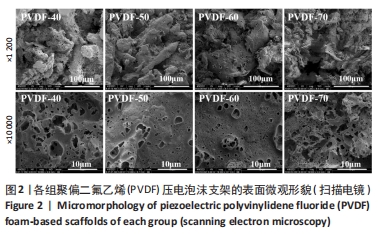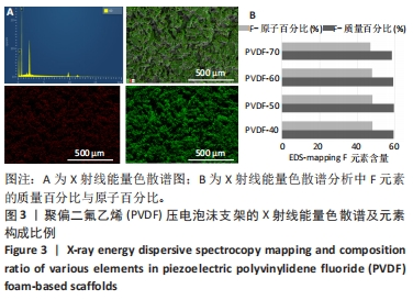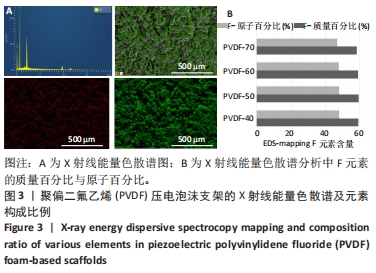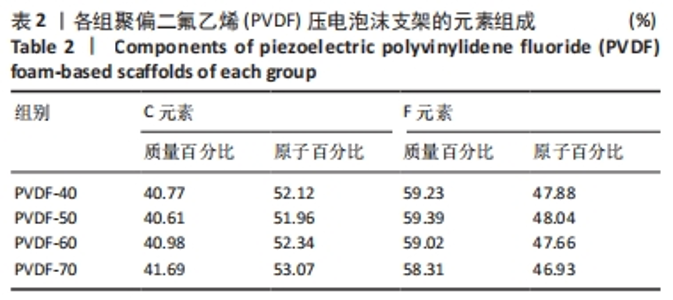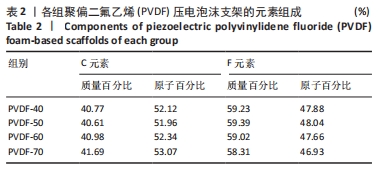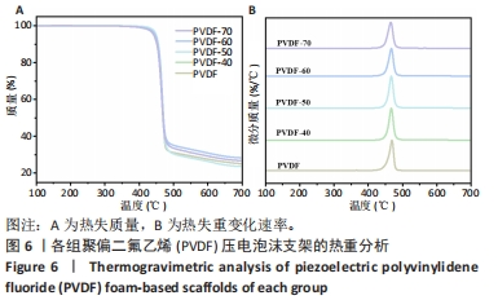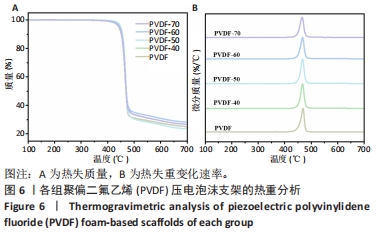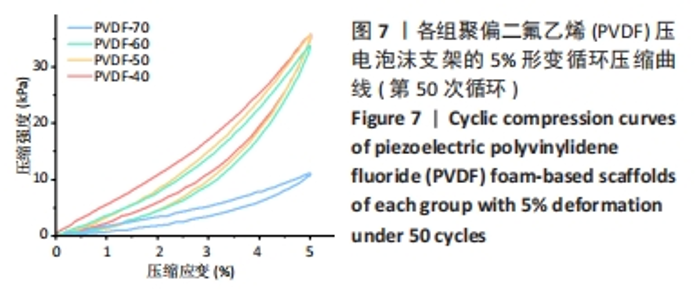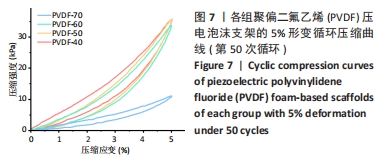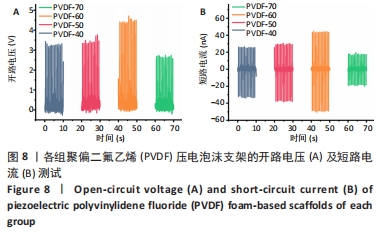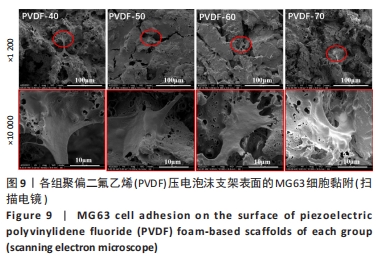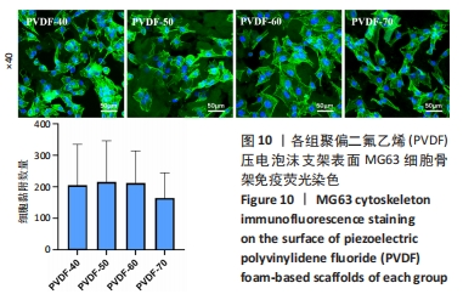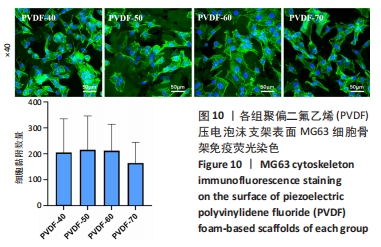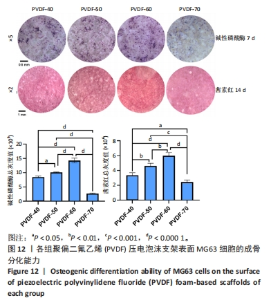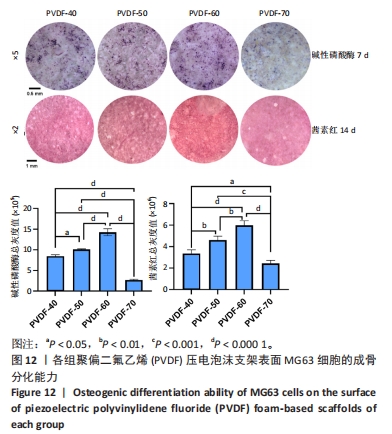Chinese Journal of Tissue Engineering Research ›› 2024, Vol. 28 ›› Issue (17): 2682-2689.doi: 10.12307/2024.472
Previous Articles Next Articles
Preparation and osteoinductivity of piezoelectric polyvinylidene fluoride foam-based scaffold
Qin Siyu1, Song Li2, 3, Chen Junyu1, Li Yijun2, Wan Qianbing1
- 1State Key Laboratory of Oral Diseases, National Center for Stomatology, National Clinical Research Center for Oral Diseases, Department of Prosthodontics, West China Hospital of Stomatology, Sichuan University, Chengdu 610041, Sichuan Province, China; 2State Key Laboratory of Polymer Materials Engineering (Sichuan University), Polymer Research Institute of Sichuan University, Chengdu 610065, Sichuan Province, China; 3Key Laboratory of Functional Polymer Materials of Ministry of Education, College of Chemistry, Nankai University, Tianjin 300071, China
-
Received:2023-06-12Accepted:2023-08-21Online:2024-06-18Published:2023-12-15 -
Contact:Wan Qianbing, Professor, Doctoral supervisor, State Key Laboratory of Oral Diseases, National Center for Stomatology, National Clinical Research Center for Oral Diseases, Department of Prosthodontics, West China Hospital of Stomatology, Sichuan University, Chengdu 610041, Sichuan Province, China -
About author:Qin Siyu, Doctoral candidate, State Key Laboratory of Oral Diseases, National Center for Stomatology, National Clinical Research Center for Oral Diseases, Department of Prosthodontics, West China Hospital of Stomatology, Sichuan University, Chengdu 610041, Sichuan Province, China -
Supported by:National Natural Science Foundation of China, No. 81970984 (to WQB); National Natural Science Foundation of China, No. 82270961 (to CJY)
CLC Number:
Cite this article
Qin Siyu, Song Li, Chen Junyu, Li Yijun, Wan Qianbing. Preparation and osteoinductivity of piezoelectric polyvinylidene fluoride foam-based scaffold[J]. Chinese Journal of Tissue Engineering Research, 2024, 28(17): 2682-2689.
share this article
Add to citation manager EndNote|Reference Manager|ProCite|BibTeX|RefWorks
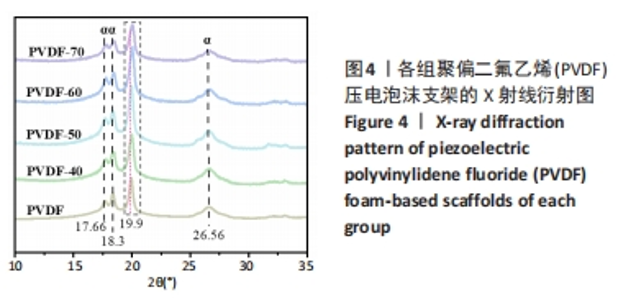
2.2 各组PVDF压电泡沫支架的结晶结构和热力学性能 2.2.1 X射线衍射分析 通过X射线衍射分析5组PVDF压电泡沫支架的晶相结构,见图4。放大 10°≤2θ≤35°范围结果,观察到在2θ=17.66°,18.30°,26.56°处均有较强的晶相衍射峰,分别对应PVDF α相的(100)(020)(110)和(021)晶面反射[21]。 NaCl的含量变化并没有导致主要衍射峰的数量和位置发生改变,说明压电泡沫支架材料成分仍为PVDF且主要为α相,没有新物质的生成。2θ=18°左右的衍射峰仅出现于α、γ相,用以与β相区分。而2θ=20°附近α、β、γ 3种晶型的特征峰较为相近,2θ=19.90°对应α相的(110)晶面反射,2θ=20.26°对应β相的(110)和(200)晶面反射,2θ=20.04°对应γ相的(110)晶面反射。2θ=19.90°的峰值略向右偏移,提示可能有β相的出现,但无法准确判断PVDF晶型改变,进一步用傅里叶变换红外光谱来分析β相特征。"
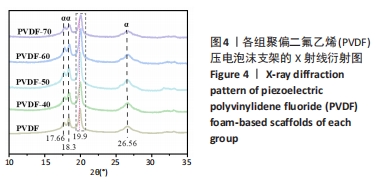
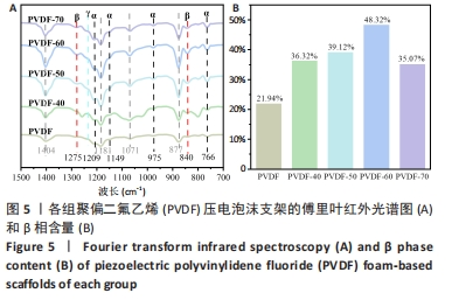
2.2.2 傅里叶变换红外光谱分析 傅里叶变换红外光谱可以定量分析检测支架内部晶型的比例,各组PVDF压电泡沫支架的傅里叶变换红外光谱分析结果,见图5A。由图可见,在877,1 071,1 181和1 404 cm?1观察到明显的α相、β相和γ相的共同特征峰,在766,975,1 149和1 209 cm?1观察到明显的α相特征峰,与X射线衍射分析结果保持一致。840 cm?1 处是具有压电效应的β相和γ相共有的特征峰,在1 279 cm-1处观察到β相特征峰,在1 234 cm-1未观察到γ相的特征峰[22]。结合X射线衍射结果,由此可以判断PVDF支架晶相构成为α相和β相,且没有γ相存在。 观察840,1 279 cm-1处的特征峰大小,PVDF-40、PVDF-50、PVDF-60组的峰波动幅度逐渐增大,PVDF-70又略减小,推测PVDF-40组、PVDF-50组、PVDF-60组的β相含量依次升高,而PVDF-70组的β相含量减少。 为了定量分析β相的相对含量,因为支架材料仅有α相和β相两种晶相,可使用Lambert-Beer 定律计算[23]:F(β)=Aα/[(Kβ/Kα)Aα+Aβ]。其中 F(β)表示β相的相对含量,Aα和Aβ代表 766 和 840 cm-1处的吸光度值,Kα和Kβ是相应波数处的吸收系数,其值分别为 6.1×104,7.7×104 cm2/mol。 各组支架β相的相对含量计算结果如图5B所示,从图中可以看出,未经固相力化学制造的PVDF对照组β 相的相对含量为21.94%,PVDF-40组提升为36%,PVDF-50组为39.12%,PVDF-60组显著提升至48.32%,PVDF-70组降低至35.07%。相比于未加入NaCl的PVDF,固相剪切碾磨技术生产出的PVDF压电泡沫支架显著诱导出了PVDF的β相,且在一定范围内β相含量随NaCl填料含量升高而升高,但NaCl填料超过一定比例之后诱导效果减弱。"
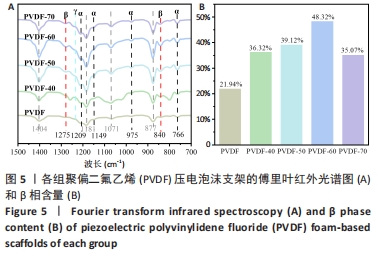
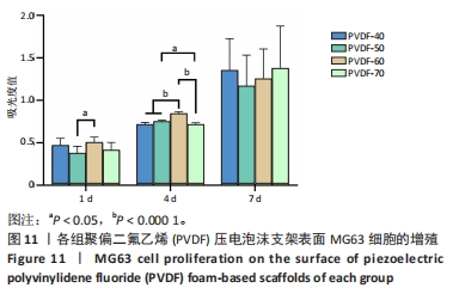
2.4.3 细胞增殖 各组PVDF压电泡沫支架表面的MG63细胞情况,见图11。随着培养时间的延长,各组细胞数量均成增长趋势,支架对细胞增殖无负向影响。培养1 d时,PVDF-60组细胞增殖吸光度值高于PVDF-50组(P < 0.05),其余组间比较差异无显著性意义(P > 0.05);培养4 d时,PVDF-50组细胞增殖吸光度值高于PVDF-70组(P < 0.05),PVDF-60组细胞增殖吸光度值高于其他3组(P < 0.000 1);培养7 d时,各组细胞增殖吸光度值比较差异无显著性意义(P > 0.05)。CCK-8结果表明不同PVDF压电泡沫支架均不影响细胞增殖,均具有良好的生物相容性。"
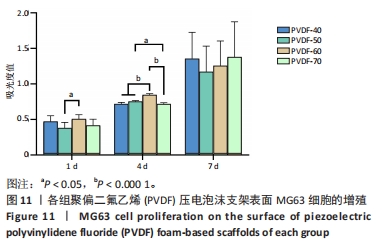
| [1] DONG Y, SURYANI L, ZHOU X, et al. Synergistic Effect of PVDF-Coated PCL-TCP Scaffolds and Pulsed Electromagnetic Field on Osteogenesis. Int J Mol Sci. 2021;22(12):6438. [2] KHARE D, BASU B, DUBEY AK. Electrical stimulation and piezoelectric biomaterials for bone tissue engineering applications. Biomaterials. 2020;258:120280. [3] KITSARA M, BLANQUER A, MURILLO G, et al. Permanently hydrophilic, piezoelectric PVDF nanofibrous scaffolds promoting unaided electromechanical stimulation on osteoblasts. Nanoscale. 2019;11(18): 8906-8917. [4] RIBEIRO C, SENCADAS V, CORREIA DM, et al. Piezoelectric polymers as biomaterials for tissue engineering applications. Colloids Surf B Biointerfaces. 2015;136:46-55. [5] 张学慧.电活性骨修复材料的研究现状与挑战[J].口腔材料器械杂志,2022,31(1):1-5. [6] 熊莹,许燕,周建平,等.组织工程研究中的电活性生物材料[J].中国组织工程研究,2019,23(34):5523-5530. [7] VIJAYAKANTH T, LIPTROT DJ, GAZIT E, et al. Recent Advances in Organic and Organic–Inorganic Hybrid Materials for Piezoelectric Mechanical Energy Harvesting. Adv Funct Mater. 2022;32(17):2109492. [8] KIM D, HAN SA, KIM JH, et al. Biomolecular Piezoelectric Materials: From Amino Acids to Living Tissues. Adv Mater. 2020;32(14): e1906989. [9] LIU Z, WAN X, WANG ZL, et al. Electroactive Biomaterials and Systems for Cell Fate Determination and Tissue Regeneration: Design and Applications. Adv Mater. 2021;33(32):e2007429. [10] 代香林,姚喜军,张文凤,等.可降解生物压电复合材料在骨组织工程中的研究进展[J].生物医学工程研究,2021,40(4):455-460. [11] MAHAPATRA SD, MOHAPATRA PC, ARIA AI, et al. Piezoelectric Materials for Energy Harvesting and Sensing Applications: Roadmap for Future Smart Materials. Adv Sci (Weinh). 2021;8(17):e2100864. [12] WANG AD, CHEN CF, QIAN JL, et al. Enhanced Electrical Properties of PVDF Thin Film by Addition of NaCl by Near-Electric-Field 3D Printing. J Electron Mater. 2021;50(8):4781-4786. [13] 许言,李平,赖春花,等.血管化骨再生中压电生物材料的应用[J].中国组织工程研究,2023,27(7):1126-1132. [14] RIBEIRO C, CORREIA DM, RIBEIRO S, et al. Piezoelectric poly(vinylidene fluoride) microstructure and poling state in active tissue engineering. Eng Life Sci. 2015;15(4):351-356. [15] MOKHTARI F, AZIMI B, SALEHI M, et al. Recent advances of polymer-based piezoelectric composites for biomedical applications. J Mech Behav Biomed. 2021;122:104669. [16] 马超,赵林,卢灿辉,等.固相力化学改性高聚物的方法研究[J].高分子通报,2011(8):48-52. [17] FISS BG, RICHARD AJ, DOUGLAS G, et al. Mechanochemical methods for the transfer of electrons and exchange of ions: inorganic reactivity from nanoparticles to organometallics. Chem Soc Rev. 2021;50(14): 8279-8318. [18] PU ZL, JIANG J, LI Y J, et al. Upcycling of waste artificial turf for high-performance wood-plastic composites. J Appl Polym Sci. 2022;139(45): e53115. [19] HUA ZK, SHI XR, CHEN YH. Preparation, structure, and property of highly filled polyamide 11/BaTiO3 piezoelectric composites prepared through solid-state mechanochemical method. Polym Composite. 2019;40:E177-E185. [20] ZHAO B, ZHAO C, WANG C, et al. Poly (vinylidene fluoride) foams: a promising low-k dielectric and heat-insulating material. J Mater Chem C. 2018;6(12):3065-3073. [21] MARTINS P, LOPES AC, LANCEROS-MENDEZ S. Electroactive phases of poly(vinylidene fluoride): Determination, processing and applications. Prog Polym Sci. 2014;39(4):683-706. [22] CAI X, LEI T, SUN D, et al. A critical analysis of the α, β and γ phases in poly(vinylidene fluoride) using FTIR. RSC Adv. 2017;7(25):15382-15389. [23] GREGORIO JR, CESTARI M. Effect of crystallization temperature on the crystalline phase content and morphology of poly(vinylidene fluoride). J Polym SCI Pol Phys. 1994;32(5):859-870. [24] PANDA AK, SITARAMGUPTA VSN, PANDYA HJ, et al. Electrical stimulation waveform-dependent osteogenesis on PVDF/BaTiO(3) composite using a customized and programmable cell stimulator. Biotechnol Bioeng. 2022;119(6):1578-1597. [25] NIU H, ZHANG H, YUE W, et al. Micro-Nano Processing of Active Layers in Flexible Tactile Sensors via Template Methods: A Review. Small. 2021;17(41):e2100804. [26] CHEN C, BAI ZK, CAO YZ, et al. Enhanced piezoelectric performance of BiCl3/PVDF nanofibers-based nanogenerators. Compos Sci Technol. 2020;192:108100. [27] ZHANG Y, YE L, ZHANG BP, et al. Characteristics and performance of PVDF membrane prepared by using NaCl coagulation bath: Relationship between membrane polymorphous structure and organic fouling. J Membrane Sci. 2019;579:22-32. [28] PAN H, NA B, LV R, et al. Polar phase formation in poly(vinylidene fluoride) induced by melt annealing. J Polym Sci Part B. 2012;50(20): 1433-1437. [29] RUAN L, YAO X, CHANG Y, et al. Properties and Applications of the β Phase Poly(vinylidene fluoride). Polymers (Basel). 2018;10(3):228. [30] UNNITHAN AR, SASIKALA ARK, SHRESTHA BK, et al. Remotely Actuated Magnetic Nanocarpets for Bone Tissue Engineering: Non-Invasive Modulation of Mechanosensitive Ion Channels for Enhanced Osteogenesis. Adv Funct Mater. 2022;32(50):2201311. [31] MADURANGA KARUNARATHNE WAH, CHOI YH, PARK SR, et al. Bisphenol A inhibits osteogenic activity and causes bone resorption via the activation of retinoic acid-related orphan receptor α. J Hazard Mater. 2022;438:129458. [32] STAEHLKE S, REBL H, NEBE B. Phenotypic stability of the human MG-63 osteoblastic cell line at different passages. Cell Biol Int. 2019;43(1): 22-32. [33] FOIS MG, TAHMASEBI BIRGANI ZN, GUTTENPLAN APM, et al. Assessment of Cell-Material Interactions in Three Dimensions through Dispersed Coaggregation of Microsized Biomaterials into Tissue Spheroids. Small. 2022;18(29):e2202112. [34] WANG A, LIU Z, HU M, et al. Piezoelectric nanofibrous scaffolds as in vivo energy harvesters for modifying fibroblast alignment and proliferation in wound healing. Nano Energy. 2018;43:63-71. [35] MCCARTHY C, CAMCI-UNAL G. Low Intensity Pulsed Ultrasound for Bone Tissue Engineering. Micromachines (Basel). 2021;12(12):1488. [36] CHEN J, LI S, JIAO Y, et al. In Vitro Study on the Piezodynamic Therapy with a BaTiO(3)-Coating Titanium Scaffold under Low-Intensity Pulsed Ultrasound Stimulation. ACS Appl Mater Interfaces. 2021;13(41): 49542-49555. [37] CAI K, JIAO Y, QUAN Q, et al. Improved activity of MC3T3-E1 cells by the exciting piezoelectric BaTiO(3)/TC4 using low-intensity pulsed ultrasound. Bioact Mater. 2021;6(11):4073-4082. |
| [1] | Yang Yufang, Yang Zhishan, Duan Mianmian, Liu Yiheng, Tang Zhenglong, Wang Yu. Application and prospects of erythropoietin in bone tissue engineering [J]. Chinese Journal of Tissue Engineering Research, 2024, 28(9): 1443-1449. |
| [2] | Wang Shanshan, Shu Qing, Tian Jun. Physical factors promote osteogenic differentiation of stem cells [J]. Chinese Journal of Tissue Engineering Research, 2024, 28(7): 1083-1090. |
| [3] | Wang Wen, Zheng Pengpeng, Meng Haohao, Liu Hao, Yuan Changyong. Overexpression of Sema3A promotes osteogenic differentiation of dental pulp stem cells and MC3T3-E1 [J]. Chinese Journal of Tissue Engineering Research, 2024, 28(7): 993-999. |
| [4] | Zhu Liwei, Wang Jiangyue, Bai Ding. Application value of nanocomposite gelatin methacryloyl hydrogels in different bone defect environments [J]. Chinese Journal of Tissue Engineering Research, 2024, 28(5): 753-758. |
| [5] | Wang Jiani, Chen Junyu. Angiogenesis mechanism of metal ions and their application in bone tissue engineering [J]. Chinese Journal of Tissue Engineering Research, 2024, 28(5): 804-812. |
| [6] | Gao Xueyu, Zhang Wentao, Sun Tianze, Zhang Jing, Li Zhonghai. Application of metal ions in bone tissue engineering [J]. Chinese Journal of Tissue Engineering Research, 2024, 28(3): 439-444. |
| [7] | Chen Pinrui, Pei Xibo, Xue Yiyuan. Function and advantages of magnetically responsive hydrogel in bone tissue engineering [J]. Chinese Journal of Tissue Engineering Research, 2024, 28(3): 452-457. |
| [8] | Long Zhirui, Huang Lei, Xiao Fang, Wang Lin, Wang Xiaobei. Characteristics of hydrogel microspheres in bone tissue engineering [J]. Chinese Journal of Tissue Engineering Research, 2024, 28(3): 472-478. |
| [9] | Zhang Jie, Xiao Tianjiao, Li Li, Kang Jiabing, Zhan Jifan, Wei Yan, Tian Ai. Interleukin-4 regulates macrophage polarization and osteogenic differentiation of bone marrow mesenchymal stem cells [J]. Chinese Journal of Tissue Engineering Research, 2024, 28(25): 3960-3966. |
| [10] | Han Yue, Wang Yufei, Liu Wanqing, Dong Ming, Niu Weidong. Effects of icariin on proliferation and differentiation of MC3T3-E1 cells in an inflammatory environment [J]. Chinese Journal of Tissue Engineering Research, 2024, 28(23): 3709-3714. |
| [11] | Dong Xinyu, Dong Xinyue, Wang Wanting, Fan Haixia, Cheng Huanzhi. The effective components of Chinese medicine combined with scaffold materials promote bone tissue regeneration [J]. Chinese Journal of Tissue Engineering Research, 2024, 28(20): 3240-3245. |
| [12] | Wang Raokaijuan, Zhao Lixing. Application of deferoxamine in bone tissue regeneration [J]. Chinese Journal of Tissue Engineering Research, 2024, 28(20): 3272-3280. |
| [13] | Gou Qiutong, Luo Wenhao, Wang Pin, Lan Yuyan, Liu Min, Huang Haixia. Berberine promotes osteogenic differentiation of bone marrow mesenchymal stem cells in a high-glucose environment [J]. Chinese Journal of Tissue Engineering Research, 2024, 28(19): 2974-2980. |
| [14] | Xie Ting, Liu Tingting, Zeng Xuehui, Li Yamin, Zhou Panghu, Yi Nianhua. Vitamin D3 attenuates high-glucose exposure-induced oxidative stress to promote osteogenic differentiation of human umbilical cord mesenchymal stem cells [J]. Chinese Journal of Tissue Engineering Research, 2024, 28(19): 2981-2987. |
| [15] | Song Yue, Shu Qing, Jia Shaohui, Tian Jun. Photobiomodulation-induced osteogenic differentiation of mesenchymal stem cells [J]. Chinese Journal of Tissue Engineering Research, 2024, 28(19): 3069-3075. |
| Viewed | ||||||
|
Full text |
|
|||||
|
Abstract |
|
|||||



